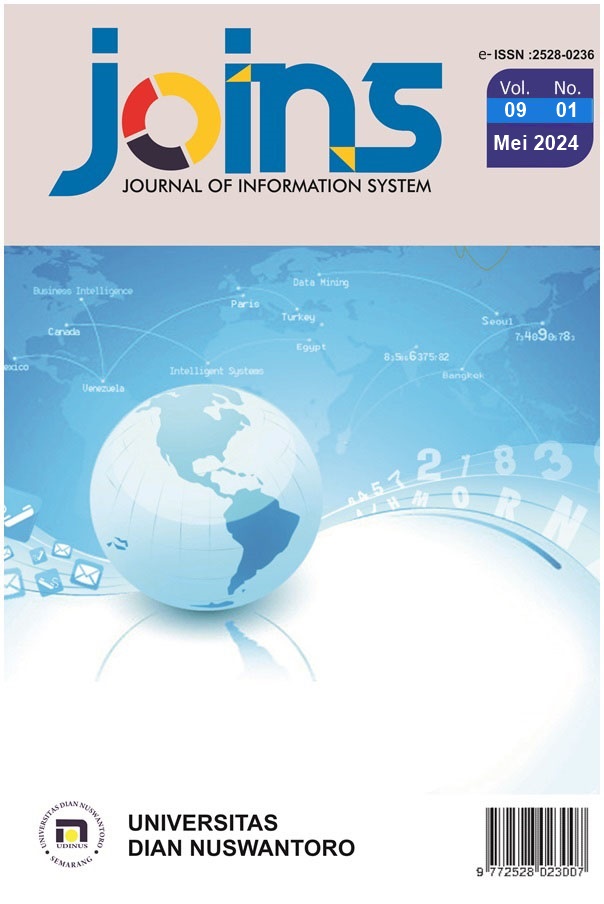Segmentasi Data Sinyal EEG Berdasarkan Domain Waktu Sebagai Dasar Dalam Pengolahan Sinyal Pengambilan Keputusan Dalam Rehabilitasi Stroke
DOI:
https://doi.org/10.33633/joins.v9i1.9561Kata Kunci:
EEG, Stroke, Segmentasi, Cleaning Data, Band Pass Filter, FeatureAbstrak
Penyakit stroke adalah salah satu penyakit kardiofaskuler jika menyerang akan menyebabkan cacad permanen dan meninggal dunia. Proses pemeriksaan membutuhkan dokter hanya berdasarkan visual unruk mendiagnosa penyakit, jika pemeriksaan dilakukan banyak dokter maka diagnose akan berbeda-beda. Unruk menghindari hal tersebut dibutuhkan alat EEG untuk mengambil aktivitas gelombang otak yang hasil pengambilan data tersebut dalam bentuk data mentah. Data mentah agar dapat dihasilkan untuk proses analisis diperlukan pemrosesan sinyal yang terdiri dari band pass filter, cleaning data, segmentasi dan decomposisi. Permasalahan selama ini yang timbul bahwa data mentah tersebt masih dalam bentuk data yang masih banyak noise baik dari pergerakan mata ataupun aktivitas otot., sehingga data mentah yang telah diolah akan menjadi dasar dalam pemilihan feature. Penelitian ini menggunakan metode penelitian menggunakan 2 tahapan yaitu data mentah dan pre processing, dimana pre processing memiliki 3 langkah yaitu band pass filter, cleaning data dan segmentasi.Hasil akhir dari penelitian ini adalah Segmentasi Data Sinyal EEG Berdasarkan Domain Waktu Sebagai Dasar Dalam Pengolahan Sinyal Pengambilan Keputusan Dalam Rehabilitasi Stroke. Kata kunci: EEG, Stroke, Segmentasi, Cleaning Data, Band Pass Filter, FeatureReferensi
A. W. de Weerd, R. J. Veldhuizen, M. M. Veering, D. C. J. Poortvliet, and E. J. Jonkman, “Recovery from cerebral ischaemia. EEG, cerebral blood flow and clinical symptomatology in the first three years after a stroke,” Electroencephalogr. Clin. Neurophysiol., vol. 70, no. 3, pp. 197–204, 1988.
N. R. Sims and H. Muyderman, “Mitochondria, oxidative metabolism and cell death in stroke,” Biochim. Biophys. Acta - Mol. Basis Dis., vol. 1802, no. 1, pp. 80–91, 2010.
J. J. M. F. Van Der Putten, J. C. Hobart, J. A. Freeman, and A. J. Thompson, “Measuring change in disability after inpatient rehabilitation: Comparison of the responsiveness of the Barthel Index and the Functional Independence Measure,” J. Neurol. Neurosurg. Psychiatry, vol. 66, no. 4, pp. 480–484, 1999.
H. S. Jørgensen, H. Nakayama, H. O. Raaschou, J. Vive-Larsen, M. Støier, and T. S. Olsen, “Outcome and time course of recovery in stroke. Part I: Outcome. The Copenhagen stroke study,” Arch. Phys. Med. Rehabil., vol. 76, no. 5, pp. 399–405, 1995.
H. JASPER, “The ten twenty electrode system of the international federation,” Electroencephalogr. Clin. Neurophysiol., vol. 10, pp. 371–375, 1958.
H. Setiawan, W. R. Islamiyah, A. D. Wibawa, and M. H. Purnomo, (2019), “Identifying EEG Parameters to Monitor Stroke Rehabilitation using Individual Analysis,” Proc. - 2019 Int. Semin. Intell. Technol. Its Appl. ISITIA 2019, pp. 337–342.
J. Frey, “Comparison of an open-hardware electroencephalography amplifier with medical grade device in brain-computer interface applications,” PhyCS 2016 - Proc. 3rd Int. Conf. Physiol. Comput. Syst., no. August, pp. 105–114, 2016.
S. Winograd, “5. FIR Filters,” Arith. Complex. Comput., pp. 39–56, 1980.
M. Y. T. Sulistyono, D. Ernawati, W. S. Sari, and S. Hadiati Nugraini, “Artifact-EOG Denoising Using FIR-Filtering in EEG Channel Selection for Monitoring and Rehabilitation of Stroke Patients,” 2022 Int. Semin. Appl. Technol. Inf. Commun. Technol. 4.0 Smart Ecosyst. A New W. Doing Digit. Business, iSemantic 2022, pp. 82–88, 2022.
##submission.downloads##
Diterbitkan
Cara Mengutip
Terbitan
Bagian
Lisensi
Authors who publish with this journal agree to the following terms:
- Authors retain copyright and grant the journal right of first publication with the work simultaneously licensed under a Creative Commons Attribution License that allows others to share the work with an acknowledgement of the work's authorship and initial publication in this journal.
- Authors are able to enter into separate, additional contractual arrangements for the non-exclusive distribution of the journal's published version of the work (e.g., post it to an institutional repository or publish it in a book), with an acknowledgement of its initial publication in this journal.
- Authors are permitted and encouraged to post their work online (e.g., in institutional repositories or on their website) prior to and during the submission process, as it can lead to productive exchanges, as well as earlier and greater citation of published work (See The Effect of Open Access).

This work is licensed under a Creative Commons Attribution 4.0 International License.






















